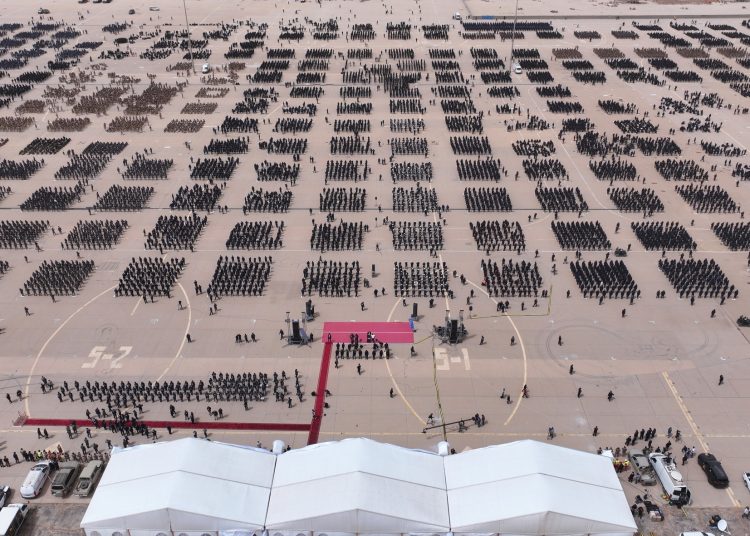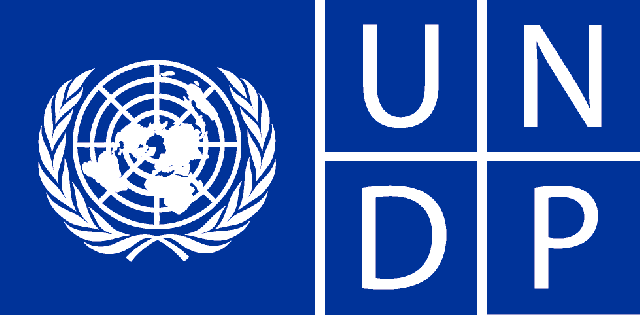The Tripoli based Ministry of Interior held its first ever congregation of thousands of members in a major display at the disused Tripoli International Airport yesterday.
The congregation was attended by a member of the Presidential Council, Abdalla Al-Lafi, Prime Minister of the Tripoli based Libyan government, Abd Alhamid Aldabaiba, and the Acting Minister of Interior, Major General Imad Mustafa Al-Trabelsi.
Tripoli government flexing its muscles – or blowing hot air?
The congregation is seen by many as the flexing of muscles by the official state police entity, the Interior Ministry, to Tripoli and western Libya’s powerful militias. It is also an attempt to send a message to the international community that the Tripoli government is in control.
The presence of the Presidency Council and Tripoli PM Aldabaiba is an indication that there is unity at the top of the state on this issue at least. Al-Lafi hails from the militia dominated and fuel smuggling epicentre city of Zawia – a city the Tripoli government security forces do not control.
Militias out of Tripoli?
At yesterday’s display, Trabelsi restated that militias will soon be out of central Tripoli. He claimed that official police forces (rather than militias) were ‘‘securing the state’s borders’’.
However, the jury is still out as to whether getting all militias out of Tripoli and securing Libya’s borders are realistic aims or just hot air? Are the powerful militias, such as Ghnewa Kikli’s Support and Stability Apparatus and Kara’s Rada/SDF prepared to vacate Tripoli?
Securing all of Libya’s borders?
Can Tripoli realistically impose its will on all four corners of Libya’s vast borderlines with Egypt in the east, (under Khalifa Hafter’s control), with Sudan in the southeast, with Chad and Niger in the south, and with Algeria and Tunisia in the west?
There is no incentive for locals to counter smuggling of goods and people in these areas. Indeed, only last week, a Sudanese confirmed to Libya Herald that he was smuggled into Libya by a local security member in the Kufra area.
Libyan Tunisian border crossing to be reopened by official (non-militia) security forces
Acting Interior Minister Trabelsi also claimed that the main Libyan Tunisian Ras Ajdair border crossing will be reopened soon by the ‘‘competent (non-militia) agencies of the two countries’’.
It will be a huge challenge for the Tripoli government to achieve this and end decades old smuggling culture across this border – a culture which locals as far as Zawia now consider a right.
Gaining control of Zawia – a litmus test for Tripoli?
Moreover, can Tripoli take control of Zawia, 47 km west of the capital, and control its refinery to end mass fuel smuggling? Noting the recent clash between official government security forces and local Amazigh/Zwaran forces – this will be a huge litmus test for Tripoli.
Strong visible presence of security forces on Tripoli’s streets
Interior Minister Trabelsi also stated in his speech that ‘‘the Ministry of Interior seeks to impose security and stability, and all police officers are present today in the streets and squares’’. There is no doubt that in many of Tripoli’s major crossroads and roundabouts there is a strong visible presence of security forces with various insignias on their vehicles.
Security against civilians or militias?
However, who are they securing Tripoli against? What is the security threat? Does it come from unarmed citizens? Does Tripoli have a serious case of armed crime from civilians? Who is the real destabilising enemy within? Is it civilians are out of control militias?
In all the major security breakdowns over the recent years – has it not been cases of militias versus militias or militias versus the official police or army?
Assumes militia leaders have control over members
Interior Minister Trabelsi also claimed that ‘‘there is great cooperation between the Ministry of Interior and the security and military services’’. The assumption here is that militia leaders exercise complete control over their members.
Second day of Eid central Tripoli militia clashes
For example, the second day of the Eid celebrations (11 April) central Tripoli militia clashes that sent families out entertaining children scurrying for safety as gunfire could be heard across the city were reportedly spontaneous. Apparently, the militia leadership had not sanctioned them. If this is the case – and it is an if – there was no consequence for this clash. No militia leader came out and apologised or announced that the culprits were being investigated or, god forbid, arrested, demoted or even sacked.
The Tripoli government, living in a parallel universe, made no comment or mention of the incident. It was once again swept under the carpet. The Tripoli government continued to claim it has control, security is good and continues to call for embassies to reopen, foreign airliners and businesses to return.
While the militia leaders may – and the jury is still out as to whether they do genuinely want to cede power to Tripoli government forces or they are just pretending – their militia members have lots to lose by giving up coercive power. It is this coercive power over unarmed civilians in government and bureaucracy that gains them wealth and influence.
Hence, while most militia leaders have already made their millions and stashed them abroad and purchased alternate homes for their possible escape – many rank and file militia members are still scooping illegal wealth. They have no incentive to give up coercive power.
Militias will open fire first with no accountability
Ultimately, what has been shown with the various militia related clashes over the recent years, is that militias are prepared to open fire first on official police and army forces and each other – while official police and army forces have been ordered not to open fire and have shown restraint.
The Tripoli government feels at least some responsibility and accountability and is worried about the loss of life. The militias have shown total impunity. They do not take responsibility and have no accountability. And once more, they know this, and they have leveraged it to their full advantage.
Five months on, GNMTC GM Tawati kidnapped again by armed militias (libyaherald.com)
UNSMIL condemns central Tripoli militia clash on second day of Eid (libyaherald.com)
Five months on, GNMTC GM Tawati kidnapped again by armed militias (libyaherald.com)
Pro Aldabaiba and pro Bashagha militias clash in Wirshafana area (libyaherald.com)
Six more militia dens vacated in Tripoli Security Plan | (libyaherald.com)
Twenty-three Tripoli militia dens now vacated as part of Security Plan | (libyaherald.com)
11 unofficial Tripoli militia dens closed as part of security plan | (libyaherald.com)
Highest-level security meeting held over Zawia militia clashes (libyaherald.com)
Pro Aldabaiba and pro Bashagha militias clash in Wirshafana area (libyaherald.com)
Major Tripoli militia clashes result in 32 deaths and 159 injuries (libyaherald.com)
Aldabaiba calls for closing of central Tripoli militia barracks (libyaherald.com)
Aldabaiba strikes at opponent Nawasi militia revenue earning projects (libyaherald.com)
More Tripoli militia clashes as the battle for legitimacy continues (libyaherald.com)
Misrata militia clashes increase Libyan tensions (libyaherald.com)
Two leading Tripoli militias clash in town centre (libyaherald.com)
Interior Ministry denounces fatal Tripoli militia clashes and road closures (libyaherald.com)
U.S. Embassy offers support to NOC after militias attempt to storm it (libyaherald.com)
Armed militias fail to storm NOC Tripoli headquarters (libyaherald.com)
Head of Serraj Media Foundation released by militias (libyaherald.com)










